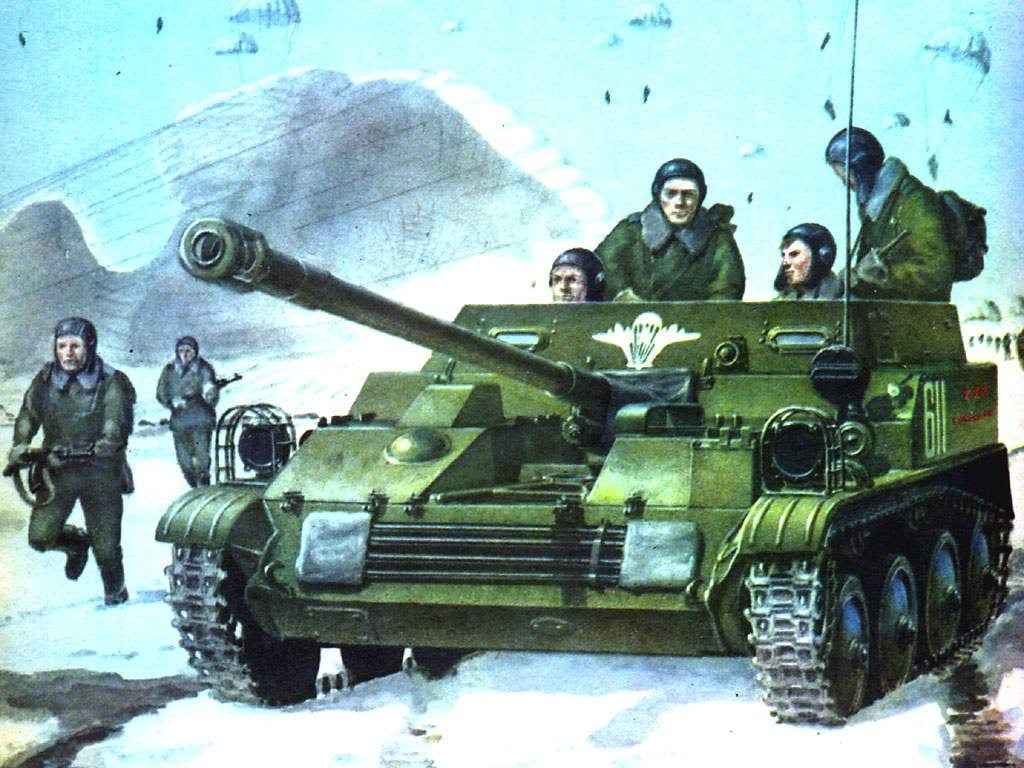ammunition 51 shot continuously could be used only 15 cartridges in the tape. To continue shooting was needed the shooter and driver in this case, the charging of the tape takes 10 to 15 minutes.
Electric trigger gun worked poor due to a lack of effort developed by the armature of the electromagnet when a voltage of 6V.
Arm guidance was uncomfortable, what if management had to exert extraordinary effort.
On top of that there was no mechanism of switching off the pump gun from the engine, which excluded the possibility of locking the gun in its stowed position.
During the tests, the equipment worked reliably. So, on the sixth kilometer of the run went down the generator. After the first shot collapsed glass spotlight due to its unfortunate location on the body of “self-propelled”.
True, the average speed of traffic on field roads and the fuel consumption is satisfactory. As for oil consumption, it was elevated. The reason for this was reinforced wear cryoseparators and piston group of the engine due to the ingress of large amounts of dust.
ASU-57 OKB-115
At the conclusion of the report on the results of the tests indicated that “a prototype airborne self-propelled <…> does not meet the requirements of modern samples of armored vehicles of this class, for the following main reasons:
a) the components and mechanisms chassis unreliable;
b) design the installation system, and a hydraulic mechanism of the unprocessed guidance, resulting in the conduct aimed fire impossible;
C) there are no basic facilities for the care and maintenance of self-propelled, which makes its operation very difficult…
Identified <…> fundamental deficiencies in the submitted sample, led to the inexpediency of further tests, therefore, the decision of the Commission, the tests were terminated at 276 km…
Water, knock out the radiator, flows down to the relays of single shots, which can cause failure in its operation.
6. The front fan really hits the seatback of the driver during the deflection as the stiffness of the back is insufficient.
7. There is easy access to the carb.
8. To adjust the valves the engine must be disassembled.
9. For removing the air cleaner must be removed nadvorny the roof.
10. For the lubrication of roller Vodaphone you need to remove the seat back of the driver, which creates an additional expenditure of time in daily maintenance…
During the tests self-propelled all transmission units worked reliably, except for the beating of lubrication:
a) from under cover of the gearbox;
b) through the hole under the probe main gear;
C) through packing of airborne transmission”.
This is the official point of view. The OKB also believe that they are not allowed to bring to the condition of the car, giving priority OKB-40 (later the Mytishchi machine-building plant), headed by H. A. Astrov.
ASU-57 (“object 572”) OKB-40 passed field testing in April 1949, the military in June of 1949. By the Navy adopted in 1951. In serial production was from 1951 to 1955
The crew of a new airborne installations in comparison with the product OKB-115 was increased to three people, and its mass with ammunition amounted to 2940 kg.
The basic data of the airborne self-propelled ASU-57
In the spring of 1950, the ASU-57 Astrov was presented at the air force Institute together with the glider Yak-14, but government tests failed. More precisely, unsuccessful fixing the self-propelled gun in the glider with the help of wooden wedges. On completion of the combat vehicle took a year, and in the summer of 1951 she off mechanism depreciation withstood repeated state tests along with a glider No. 1681005 as towed behind the aircraft Il-12T, and in free flight. However, unsuccessful device, the outlet exhaust gases from the engine-propelled. When starting the motor in flight could ignite offer percale trim of the glider.
The crew of the ASU-57 was located on the easily removable seats in the rear cargo compartment of the airframe and liaised with the crew of the Yak-14 on the intercom.
Replacement of wooden wedges to block the ASU-57 mechanism off depreciation allowed not only facilitate curb the airframe, but also reduce the time preparing it for flight.
ASU-57 was in service with airborne forces until the mid 1970-ies.
 In 1947 in accordance with the September decision of the government in the aviation experimental design Bureau (OKB-115), headed by A. S. Yakovlev, began development of a heavy landing glider Yak-14 and simultaneously — airborne self-propelled ASU-57. Caterpillar machine was built in the beginning of 1948, and, after a short factory test in April passed on field tests in the research test an armored polygon BT and MV VS (NIIBT Polygon).
In 1947 in accordance with the September decision of the government in the aviation experimental design Bureau (OKB-115), headed by A. S. Yakovlev, began development of a heavy landing glider Yak-14 and simultaneously — airborne self-propelled ASU-57. Caterpillar machine was built in the beginning of 1948, and, after a short factory test in April passed on field tests in the research test an armored polygon BT and MV VS (NIIBT Polygon).